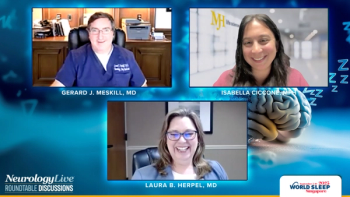
Poor Sleep Quality Correlated With Higher Neurofilament Light Levels in Veterans
Neurofilament light, a biomarker elevated in neurodegeneration and dementia, was higher among poor sleepers with Pittsburgh Sleep Quality Index scores of less than 5.
In a cross-sectional study of veterans without a clinical diagnosis of dementia, findings showed that poor sleep quality was associated with short sleep duration, mild cognitive impairment, and higher serum levels of neurofilament light. Investigators noted that additional studies with more varied populations are needed before clinical recommendations can be made.
Presented at the
Led by Carleara Weiss, PhD, MS, RN, postdoctoral fellow, Jacobs School of Medicine, University at Buffalo, cognition was assessed with the St. Louis University Mental Status Exam (VA-SLUMS) while dementia biomarkers were identified with an automated immunoassay system that used enzyme-linked lectin assay. In addition to showing shorter sleep duration, poor sleepers exhibited more mild cognitive impairment, as represented by scores on VA SLUMS (26.9; P = .01), and higher serum NfL levels (mean, 66.7; P = .04).
Sleep and 24-hour activity rhythm disturbances have been associated with the development of neurodegenerative diseases and related pathophysiological processes in the brain. Weiss et al noted that the results may contribute to the early identification of dementia and sleep-centered treatment guidance; however, also warned that further studies with larger cohorts are needed to validate these findings. To date, the literature on the association between sleep and NfL has been mixed, with some suggesting little to no correlation.
READ MORE:
A recent cross-sectional study published in 2020 examined the relationship of sleep and 24-hour activity rhythm disturbances with plasma-based biomarkers that could potentially signal neurodegenerative disease. Using linear regression, adjusting for relevant cofounders and correcting for multiple testing, the data showed no associations of self-rated sleep, actigraphy-estimated sleep, and 24-hour activity rhythms with NfL. Of note, the study did show a non-linear association of self-rated time in bed with NfL (P = 2.5*10-4), but no associations with other biomarkers of amyloid-ß(Aß)40 and Aß42, and total tau after multiple testing correction.
Another study looking at the relationship between sleep quality and cerebrospinal fluid markers fo AD pathology in late midlife showed that self-report of poor sleep was associated with greater AD-related pathology, and that sleep healthy may be a tractable target for early intervention. Using a cohort of 101 participants (mean age, 62.9 years; 65.3% female), worse subjective sleep quality, more sleep problems, and daytime somnolence were correlated with lower CSF Aß42/Aß40 and higher t-tau/Aß42, p-tau/Aß42, monocyte chemoattractant protein-1/Aß42, and chitinase-3-like protein 1/Aß42. The study did not find significant associations with sleep and NfL or neurogranin.
REFERENCES
1. Weiss C, Lorenz R. Short sleep duration and poor sleep quality associated with elevated serum NfL and mild cognitive impairment in older veterans. Presented at: 2023 SLEEP Annual Meeting; June 3-7; Indianapolis, Indiana. Abstract 0096
2. Lysen TS, Ikram MA, Ghanbari M, Luik A. Sleep, 24-h activity rhythms, and plasma markers of neurodegenerative disease. Sci Rep. 2020;10:20691. doi:10.1038/s41598-020-77830-4
Newsletter
Keep your finger on the pulse of neurology—subscribe to NeurologyLive for expert interviews, new data, and breakthrough treatment updates.




































